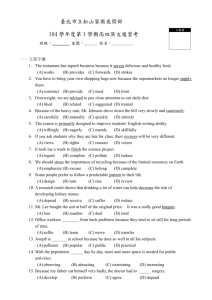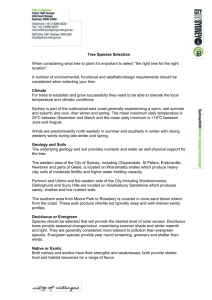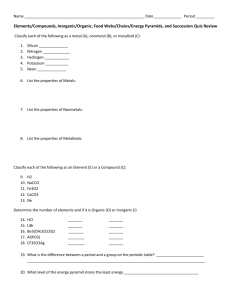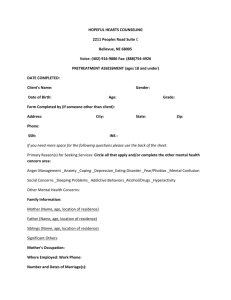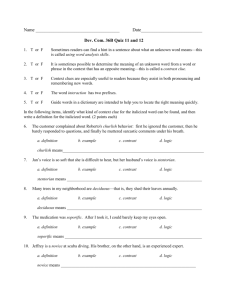Native Florida Trees and Shrubs for Urban Wildlife
advertisement
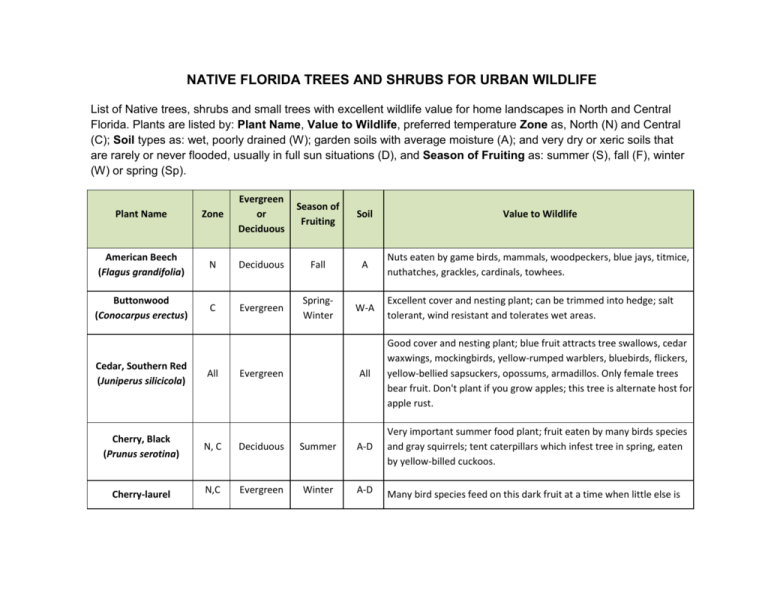
NATIVE FLORIDA TREES AND SHRUBS FOR URBAN WILDLIFE List of Native trees, shrubs and small trees with excellent wildlife value for home landscapes in North and Central Florida. Plants are listed by: Plant Name, Value to Wildlife, preferred temperature Zone as, North (N) and Central (C); Soil types as: wet, poorly drained (W); garden soils with average moisture (A); and very dry or xeric soils that are rarely or never flooded, usually in full sun situations (D), and Season of Fruiting as: summer (S), fall (F), winter (W) or spring (Sp). Plant Name Zone Evergreen or Deciduous American Beech (Flagus grandifolia) N Deciduous Fall A Buttonwood (Conocarpus erectus) C Evergreen SpringWinter W-A Cedar, Southern Red (Juniperus silicicola) All Season of Fruiting Soil Value to Wildlife Nuts eaten by game birds, mammals, woodpeckers, blue jays, titmice, nuthatches, grackles, cardinals, towhees. Evergreen Excellent cover and nesting plant; can be trimmed into hedge; salt tolerant, wind resistant and tolerates wet areas. All Good cover and nesting plant; blue fruit attracts tree swallows, cedar waxwings, mockingbirds, yellow-rumped warblers, bluebirds, flickers, yellow-bellied sapsuckers, opossums, armadillos. Only female trees bear fruit. Don't plant if you grow apples; this tree is alternate host for apple rust. Cherry, Black (Prunus serotina) N, C Deciduous Summer A-D Very important summer food plant; fruit eaten by many birds species and gray squirrels; tent caterpillars which infest tree in spring, eaten by yellow-billed cuckoos. Cherry-laurel N,C Evergreen Winter A-D Many bird species feed on this dark fruit at a time when little else is (Prunus caroliniana) available; can be used as an informal privacy hedge. Crabapple, Southern (Malus angusifolia) N Cypress, Bald (Taxodium distichum) Cypress, Pond (T. ascendens) ALL Deciduous Fall-Winter Dogwood, Flowering (Cornus florida) N,C Deciduous Fall A Elm, Winged (Ulmus alata) N,C Deciduous Spring W-A Early source of seeds for many songbirds, including finches, sparrows, grosbeaks; fox and gray squirrels and rabbits also utilize elm fruits. Fall W-A Blue fruit eaten by many birds, including woodpeckers, blue jays, bluebirds, cardinals, wood ducks and others; hollows in old trees used by birds and mammals; flowers important for bees. Summer A Cluster of red fruit eaten by mockingbirds and vireos; warblers and flycatchers often see in canopy. Gum, Black or Tupelo (Nyssa sylvatica) Gumbo-limbo (Bursear simaruba) N,C,S Deciduous Deciduous C (Barrier Deciduous islands) Summer A W-A Fruit eaten by mockingbirds and other bird species. Seed cones used by gray squirrels, ducks, sandhill cranes, other; longlived pest-free tree. Bright red fruit very attractive to many species of birds. Hackberry or Sugarberry (Celtis laevigata) All Deciduous SummerFall All Dark fruit eaten by many birds, including catbirds, mockingbirds, robins, thrashers, towhees, cedar waxwings, flickers; butterfly larvae. Hawthorn (Crataegus spp.) N,C Deciduous SpringSummer A Red or yellow fruit eaten by birds and mammals, including foxes, otters, rabbits; provides good cover and nesting sites; thorny. Hickory (Carya spp.) N,C Deciduous Fall Nuts eaten by squirrels, wood ducks, blue jays, woodpeckers and crows. A HOLLIES (Ilex spp.) American (I. opaca) Yaupon (I. Vomitoria) N,C N,C A Evergreen Fall-Winter All Dahoon (I. Cassine) All Hornbeam, American (Carpinus caroliniana) N,C Magnolia, Southern (Magnolia grandiflora) Deciduous SummerFall Nuts eaten by squirrels and some birds. A N,C Evergreen Good cover for songbirds; red fruit eaten by woodpeckers, red-eyed vireos and others. Fall Magnolia, Sweetbay (M. Virginiana) Maple, Red (Acer rubrum) Maple, Florida Sugar (A. barbatum) W-A Female plants bear red fruit that persists into the winter; eaten by many species of birds; good cover; yaupon holly is salt tolerant; summer plants important source of pollen for bees. W-A All Deciduous Summer A Winged seeds eaten by some birds and mammals Mulberry, Red (Morus rubra) All Deciduous Spring W-A Usually only female plants bear fruit; abundant berries attract woodpeckers (including pileated), kingbirds, great crested flycatchers, blue jays, crows, titmice, mockingbirds, thrashers, grackles, summer tanagers, cedar waxwings, opossums, raccons, squirrels. OAKS (Quercus spp.) Live Oak (Q virginiana) All Evergreen Fall-Winter A-D White Oak (Q. alba) N Deciduous Fall-Winter A Basket Oak (Q. michauxii) N,C Deciduous Fall-Winter A Laurel Oak (Q. laurifolia) N,C Evergreen Fall-Winter W-A Myrtle Oak (Q. myrtifolia) N,C Fall-Winter A-D Shumard Oak (Q. shumardii) N,C Deciduous Fall-Winter A Water Oak (Q. nigra) N,C Deciduous Fall-Winter W-A Palm, Cabbage or Sabal All Evergreen Fall All Acorns are a primary wildlife food source and have high energy value; eaten by game birds, woodpeckers (Especially red-headed), blue jays, raccoons, quail, gray squirrels, flying squirrels, bears; provides good cover and nesting sites, den trees and nesting materials, including lots of Spanish moss; many warbler species may be found in live oaks feeds on insects; live oak is salt tolerant. Our state tree, white flowers attract honeybees and other insects; black fruit eaten by many birds, especially robins, grackles, mockingbirds, thrashers, red-bellied woodpeckers, catbirds, and raccoons; palm thatch used as nest building materials; frogs, lizards and insects live in crown where moisture collects; salt tolerant. (Sabal palmetto) Persimmon (Diospyros virginiana) All Deciduous Fall All Female plants bear fleshy fruit in the fall and often persist into winter; important food for raccoons, opossums, foxes, skunks and many birds. PINES (Pinus ssp.) Slash Pine (P. elliottii) All All Longleaf Pine (P. palustris) N,C All Loblolly Pine (P. taeda) N,C Spruce Pine (P. glabra) N,C A Sand Pine (P.clausa) N,C D Sea Grape (Coccoloba uvifera) Evergreen C (Barrier Evergreen islands) Fall SummerFall All A Pine seeds are of major importance to wildlife, although the crop of seeds varies considerably from year to year; good cover; seeds eaten by chickadees, blue jays, nuthatches, pine siskins, quail, pine warblers and other birds, as well as fox squirrels and gray squirrels; old growth pines provide good nesting cavities; slash pine is salt tolerant. Good honey plant; fleshy fruit eaten by raccoons, turtles and various bird species; salt tolerant. Strangler Fig (Figus aurea) Sweetgum (Liquidambar styraciflua) C (Barier Evergreen islands) N,C Wild Lime C (Zanthoxylum fagara) (Coast) SpringWinter All Deciduous Fall-Winter Evergreen Summer W-A A Attracts swarms of cedar waxwings and many other birds; invasive roots. Seeds in "gum balls" eaten by goldfinches, siskins, wrens, chickadees, titmice, cardinals, quail and purple finches. Excellent butterfly plant. Shrubs and Small Trees Plant Name Zone Evergreen or Deciduous American Beautyberry (Callicarpa americana) All Deciduous Season of Fruiting Soil Fall All Bright purple berries eaten by woodpeckers, mockingbirds, cardinals and other bird species. Value to Wildlife Blackberry (Rubus spp.) N,C Deciduous Summer All Berries are one of the most valuable summer foods for wildlife, berries eaten by many birds species and raccoons, squirrels, box turtles; excellent cover for wildlife. Blueberry (Vaccinium spp.) N,C,S Deciduous Summer All Blueberries are an important summer food source for wildlife; eaten by many bird and mammal species; good for hedgerows. Buckeye, Red (Aesculus pavia) N,C A Red tubular flowers feed hummingbirds; nutlike fruit eaten by squirrels in fall. Deciduous Fall-Winter Cactus, Prickly Pear (Opuntia spp.) All Evergreen SummerFall A-D Coffee, Wild (Psychotria nervosa) C Evergreen Summer A Fleshy red berries widely used by wildlife species. Coral Bean (Erythrina herbacea) All Deciduous Fall-Winter All Red flowers provide nectar for hummingbirds. Elderberry (Sambucus canadensis) All Evergreen SummerFall W-A Excellent summer source of food for wildlife; deep purple fruit eaten by many bird species. Fringe Tree (Chionanthus virginicus) N,C Deciduous SummerFall W-A Fruits eaten by many birds and mammals. Marlberry (Ardisia escallonioides) C (Coast) Evergreen SpringWinter A SpringWinter Persistent fruit eaten by raccoons, gopher tortoises; Florida box turtles, eastern woodrats. Purple fruit eaten by most fruit-eating birds. Myrsine (Myrsine floridana) C Evergreen Palmetto, Saw (Serenoa repens) All Evergreen SpringSummer All Spring flowers provide nectar for honeybees; fruit eaten by several bird species and raccoons; excellent cover. Pokeweed (Phytolacca All Deciduous SummerFall All A weed worth cultivating; dark purple fruit eaten by many songbirds, including bluebirds, cardinals, thrashers, thrushes, waxwings, A-W Good food, cover and nesting sites for many birds; good hedge plant for barrier islands. raccoons, opossums and foxes. Pokeweed is extremely poisonous to humans. americana) Evergreen SpringSummer A Spring flowers attract insects during spring migration, and many warblers come to feast on the insects; small dark fruit on plants consumed by a number of species. N,C Deciduous SummerFall A Dark blue fruit eaten by kingbirds, crested flycatchers, phoebes, pileated woodpeckers, mockingbirds, thrashers, catbirds and flickers. Sumac, Winged (Rhus copallina) N,C Deciduous Fall-Winter All Fruit is not preferred but is consumed by songbirds in late winter when little else is available. Torchwood (Amyris elemifera) C Evergreen Summer A Valuable larval food plant for Schaus' swallowtail butterfly. Viburnum (Viburnum spp.) N Deciduous Fall W-A Berries of native viburnums eaten by several bird species. Privet, Florida (Forestiera segregata) C Sassafras (Sassafras albidum) Wax Myrtle (Myrica certifera) All Evergreen Fall-Winter All Female plants produce small waxy berries; eaten by many species of birds, especially yellow-rumped warblers, white-eyed vireos, rubycrowned kinglets and quail; flocks of tree swallows will often swarm to feed on berries; excellent hedge plant; salt tolerant. David Nistler, University of Florida IFAS Clay County Extension, 1/25/2013
